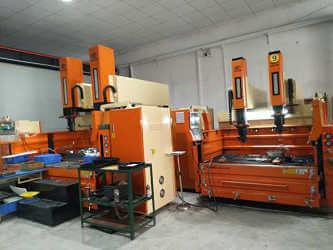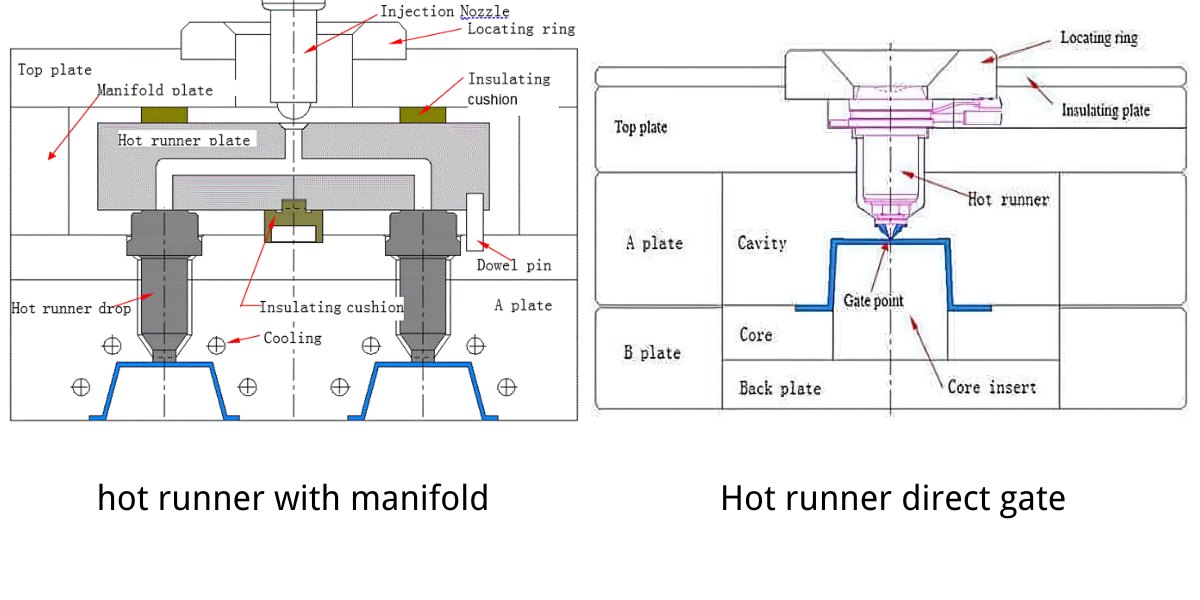Plastic injection molding is a widely used manufacturing process. In today’s world, this method has become essential for producing large-scale plastic parts. Its popularity is due to its fast, accurate, and highly efficient operation.
Plastic injection molding typically allows you to create countless plastic items. Most of these plastic parts are your daily items, from your smartphone casting to the handle on your toothbrush.
Plastic injection molding allows you to make thousands, even millions, of identical parts. Of course, these plastic parts come with tight tolerances up to 0.01mm. This level of precision creates accurate designs and products that make the product effective and look good. Injection-molded products are widely used in the car, consumer goods, and electronics industries.
Plastic injection molding involves several key stages. Each stage here is critical. In this article, we’ll dive into these stages so you can see how products go from raw plastic to ready-to-use parts. Moreover, you’ll learn about the plastic injection molding services offered in a factory. This article will be a comprehensive guide, so let’s get started.
What Is Plastic Injection Molding?
Injection molding is a prevalent manufacturing method. The term is divided into “injection” and “molding.” As the name indicates, this process entails injecting material into a mold. Plastic injection molding refers to the use of plastic.
This method shapes parts of various designs by injecting the molten material into the plastic injection mold. It is widely used to make plastic parts quickly and accurately. Once the mold is ready, you can create hundreds or millions of plastic parts. The process is highly efficient and offers consistent quality. As a result, people prefer this method to create complex shapes and precise details.
This procedure is not limited to plastic toy pieces or containers. Plastic injection molding is critical to numerous industries. Take the auto industry, for example. Almost every vehicle on the road today features injection-molded components, such as dashboards.
Electronics such as laptops, smartphones, and more depend significantly on this process. Most of their internal components, casings, and joints are injection molded.
In the medical industry, accuracy is essential, and injection molding delivers just that. The process yields precise tolerances for surgical tools, syringes, and other medical items.
Then there’s the consumer goods industry. Injection molding mostly makes our everyday items. Typical examples are kitchen utensils, plastic jars, bottles, furniture, food containers, and more.
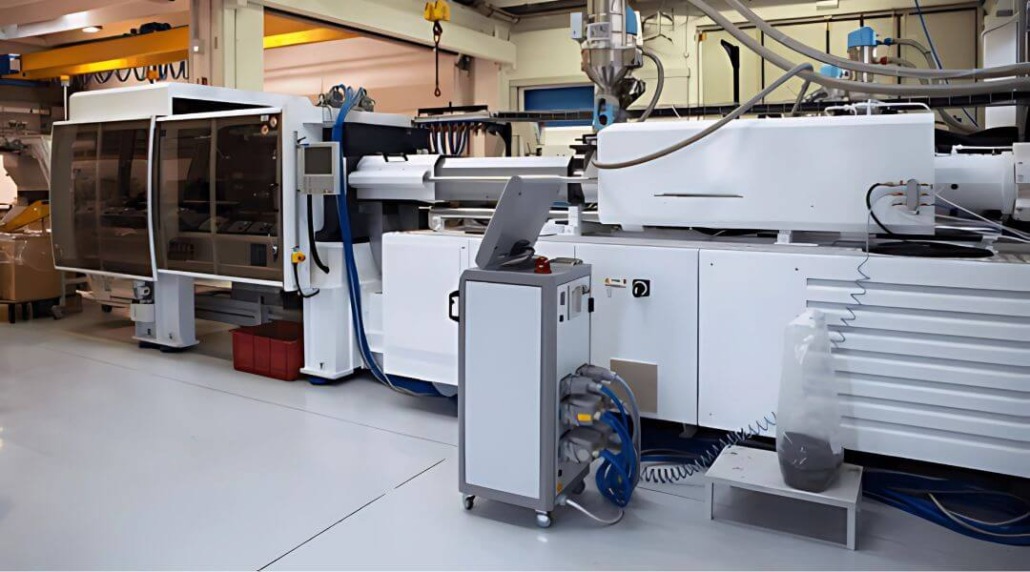
Benefits of Plastic Injection Molding Compared to Other Methods
There are various types of plastic-forming methods. Some popular ones are extrusion molding, compression molding, blow molding, and rotational molding. Now, what are the benefits you can get from the plastic injection molding method?
Precision and Complexity
One of the best things about plastic injection molding is precision and complexity. Extrusion molding or compression molding typically deals with simpler shapes. Therefore, these methods are not suitable for complex shapes.
Plastic injection molding, on the other hand, can handle more complex geometries with related mold structure. This method also allows you to work with thin walls, tight tolerances, and small and fine details. You can get the highest quality plastic products compared to any other methods.
High Production Speed
Time is valuable, especially in manufacturing. Plastic injection molding is built for speed. Once the injection mold is set up, it can produce parts rapidly, much faster than traditional or blow molding. This speed makes plastic injection molding process a go-to option for high-volume production. It’s one of the fastest methods out there.
You will be surprised to learn that plastic injection molding can make thousands of plastic parts in an hour. This method can save time and money simultaneously.
Minimal Waste
Plastic injection molding is efficient in material use. If you can make the mold correctly and precisely inject the plastic, you can minimize excess plastic—extrusion molding, where continuous material flow often leads to scraps.
In plastic injection molding, the extra plastics can be used further, reducing injection molding costs and contributing to a green environment.
Consistent Quality
Plastic injection molding also ensures uniform products. One plastic injection mold can produce millions of plastic products with the same shape and properties. It’s tough to achieve exact uniformity with compression and blow molding, but you can do it precisely with injection molding. It reduces the cost and meets the demand for high-quality products.
Versatile Material Choice
There are many types of plastics out there that are widely used in many applications. They are not all the same, and each type has its unique application. Injection molding can easily accommodate a wide range of materials. This flexibility allows you to meet a specific need. This means you can meet exact strength, durability, and flexibility properties.
Superior Finish
Injection molding creates parts with smooth surfaces and a clean finish. This method eliminates or reduces the need for post-processing. Rotational molding, on the other hand, is pretty tricky and requires extra finishing.

What is an Injection Molding Machine?
A plastic injection molding machine is a simple piece of equipment. It has several vital components that work together to produce plastic parts. In general, there are three central units in a plastic injection molding machine. Each element plays a crucial role in the plastic injection molding process.
Clamping Unit
The clamping unit holds the mold tightly in place during the injection process. It acts as a grip so the mold doesn’t slip, allowing you to change it based on the final product design.
When the machine begins, the clamping unit closes the mold halves. It uses high pressure, primarily hydraulic pressure, to prevent plastic from leaking during injection.
After the part cools, the clamping unit opens the mold to release the finished product. Without this unit, the process would be a mess.
Injection Unit
The injection unit, on the other hand, is the heart of the machine. It melts the plastic granules and injects them into the mold. The injection unit has a hopper that feeds the plastic into a heated barrel. The material is melted inside the barrel until it reaches a liquid state. Then, a screw or plunger pushes the molten plastic into the mold.
Control Unit
Note that this whole process must be appropriately controlled. Otherwise, the final product might get messy. For example, temperature control is critical in this process. You must set the temperature at the right level so that your final product doesn’t have defects. On the other hand, injection time, ejection time, and pushing force should also be adequately controlled.
What is Injection Mold?
As mentioned in the previous section, the clamping unit typically holds the injection mold. The injection mold is part of the clamping unit and shapes molten plastic into specific forms.
Injection molds are commonly made of tool steel. A variety of tool steels can be used to make injection molds. P-20 28-30 RC, S-7 pre-hardened tool steel 56 RC, H-13, and 420 are noteworthy. These tool steels are strong and durable, and the material must be strong enough to withstand millions of plastic products.
An injection mold comprises two essential parts: the cavity and the core. The cavity is the hollow space that the plastic occupies. It determines the outward form of the component. The core, on the other hand, determines the interior details. Together, they create a complete part.
You can realize the importance of a high-quality mold in making plastic injection-molded parts. The quality of the injection mold also determines the quality of the final parts. Therefore, you must first ensure the quality of the injection mold.
A well-designed mold leads to fewer defects and reduces production time and costs. Poor design may result in warping and inconsistent quality. So, seeking professional help when designing your first injection mold is wise.
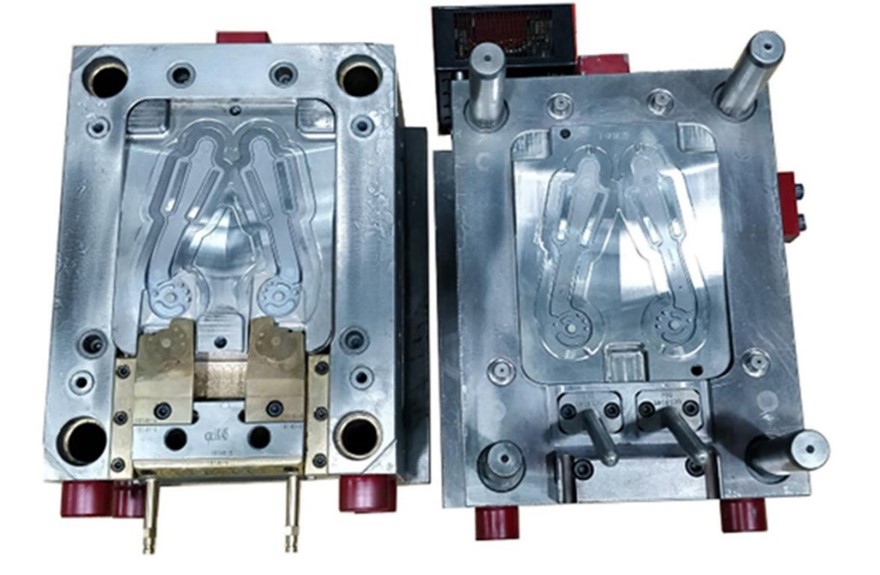
How Does Injection Molding Work?
You have already gone through a comprehensive study of injection molding. You are also familiar with the various components of an injection molding machine. In this section, you will learn how injection molding works.
Clamping
The first step in the injection molding process is clamping. Here, the two halves of the mold are brought together. This is the crucial stage. If the mold isn’t clamped tightly, molten plastic can escape, which may create defects in your final parts.
The clamping unit holds the mold halves together with significant force. The force or pressure must be strong enough to withstand the pressure of the injected material. If it’s too weak, the mold will open during injection, causing a mess. Too much force can damage the mold.
So, how do you determine the correct clamping force? Consider aspects such as the part’s size and the plastic utilized. For example, bigger pieces need more force. The goal is to get a tight fit without overdoing it. Once the mold is firmly closed, we proceed to the next step.
Injection
The plastic material is fed into the injection molding machine at this stage. The raw plastic, usually in pellet form, is heated until it melts into a thick, gooey substance.
It is pouring syrup into a mold. The molten plastic is poured into the mold cavity under high pressure, ensuring that it fills every nook and corner. If the pressure is too low, the mold cannot fill. It is important to note that improper pressure might result in weak or incomplete portions.
Speed is also critical during injection. The faster the material is injected, the less time it has to cool before filling the mold. But there’s a problem. Doing it quickly can create turbulence, the main cause of a few defects. Therefore, you must carefully balance speed and pressure.
Dwelling
The dwelling phase is also critical in the plastic injection molding method. As you know, you must maintain appropriate pressure while filling the mold. When the plastic is injected, it doesn’t always fill the mold evenly. There might be air pockets or gaps. To avoid this issue, you must hold the pressure steady. This way, you can ensure no trapped air inside. This is where the dwelling phase comes in.
The dwelling time can vary depending on the material and part design. Too short a dwelling time can lead to incomplete parts, while too long can waste time and energy.
Cooling
Once the dwelling phase is complete, it’s time for cooling. This is where the real transformation happens. The molten plastic begins to solidify as it cools. The cooling stage must be maintained properly to set the shape of the part.
This stage usually takes longer than the dwelling stage. In this case, the mold’s temperature generally plays the leading role. You could use an air or water cooling system. Warping might happen if the mold is too cold, so be careful!
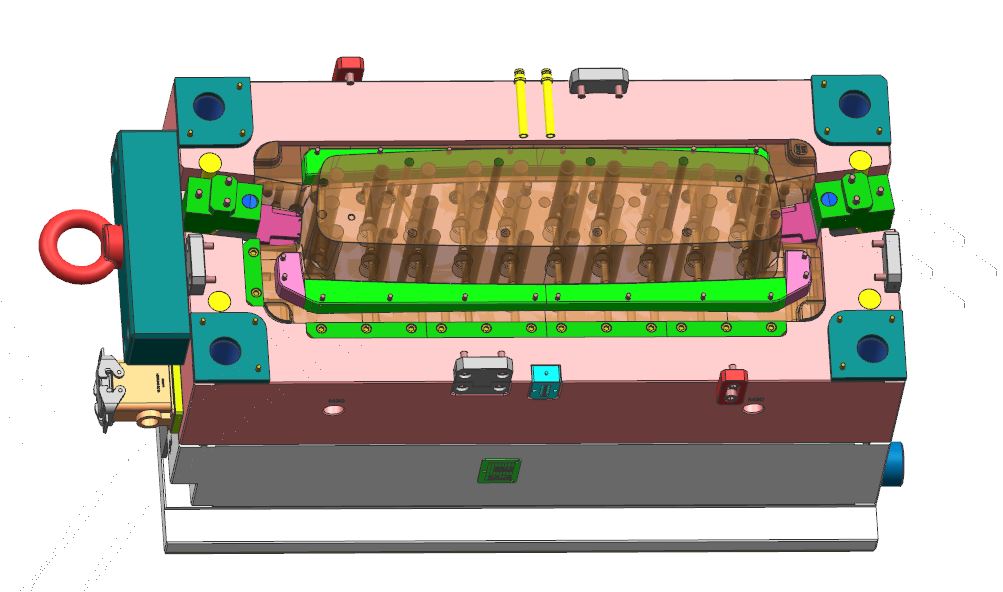
Mold Opening and Removal of Products
After cooling, it’s time to release the final part. Usually, the ejector pin does this. The clamping unit releases the pressure, generally allowing the two halves to separate. If you do it incorrectly, it can damage the mold or the finished part.
Once the mold is open, you can remove it using tools or hand. Once removed, the part is inspected again. It might undergo further processing, such as trimming or surface finishing.
Plastic Injection Molding Materials
One of the best benefits of plastic injection molding is its versatility. You can generally work with various plastic injection molding materials in injection molding manufacturing. Selecting the suitable material from this diverse list depends on your project needs. Remember, each material here has its unique strengths and weaknesses. Do you need flexibility? Go for PE or PP. Want Toughness? Try ABS or PC.
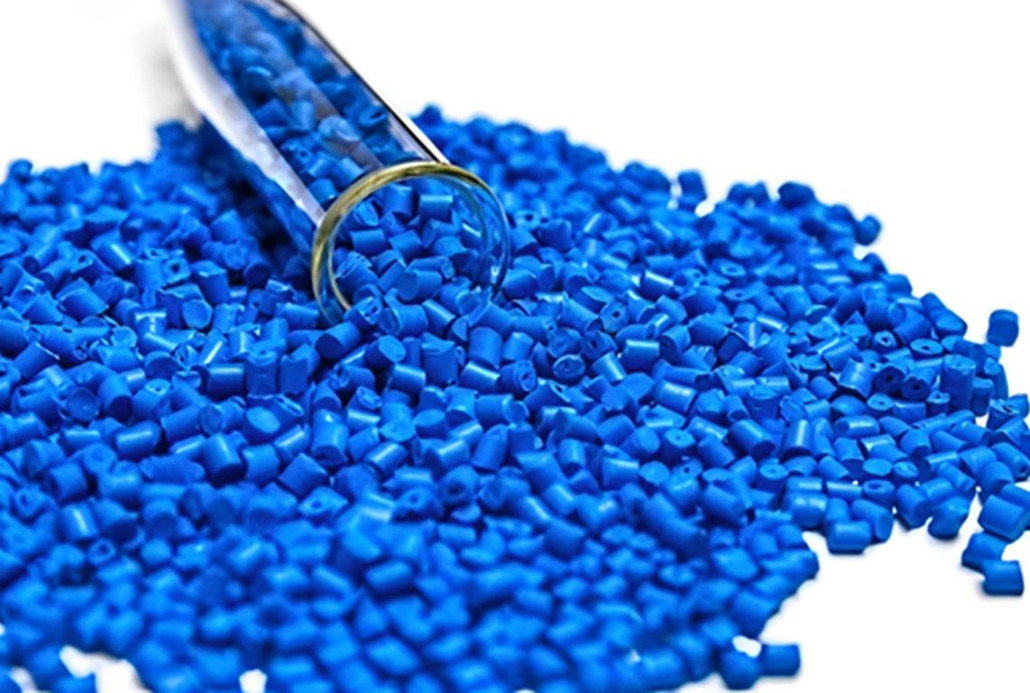
Polyethylene (PE)
This plastic is incredibly lightweight and flexible. It is also very resistant to chemicals and moisture, making it a popular choice for containers and bottles.
Polyethylene is one of the most widely used plastics globally due to its incredibly lightweight, flexible and cost-effectiveness. It is also very resistant to chemicals and moisture, making it a popular choice for containers and bottles.
There are various type of PE materials, including Low-Density Polyethylene (LDPE), High-Density Polyethylene (HDPE), and Ultra-High Molecular Weight Polyethylene (UHMWPE), each one uses to different applications but very similar.
Properties: Lightweight, flexible, moisture-resistant, and resistant to many chemicals. PE is relatively soft but has good impact resistance. It can handle low temperatures but has limited resistance to high temperatures.
Types of PE materials:
- LDPE: Known for its flexibility, commonly used in film applications like plastic bags.
- HDPE: Stronger and more rigid, used in items like milk jugs, detergent bottles, and pipes.
- UHMWPE: Extremely tough with excellent wear resistance, often used in industrial applications, such as conveyor belts and bulletproof vests.
Applications: Due to its variety, PE is used across industries for containers, piping, and even high-wear applications. In the food industry, it’s ideal for food containers, food packaging due to its moisture resistance. Go to PE injection modling and HDPE injection molding page to know more about this PE material.
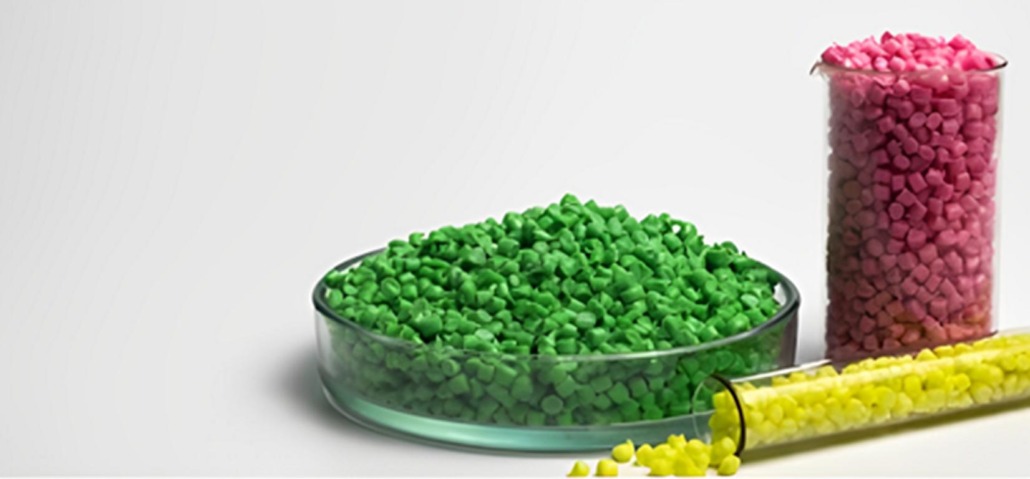
Polypropylene (PP)
Polypropylene is another popular choice. It is prevalent for being strong and very resistant to fatigue, it provides excellent temperature resistance.It’s available in homopolymer and copolymer forms, with each variation suitable for specific applications.
Properties: Strong, durable, fatigue-resistant, and excellent temperature resistance. PP can endure repetitive bending, making it suitable for applications like living hinges.
Advantages: PP offers high chemical resistance and is lightweight, yet stronger than PE. It’s also resistant to absorbing moisture, making it ideal for long-lasting products.
Applications:
- Automotive: Frequently used in automotive parts like bumpers, dashboards, and battery cases.
- Consumer Goods: Found in reusable containers, furniture, textiles, and packaging. Its fatigue resistance makes it useful for hinges in household products and storage containers.
- Medical: Sterilizable and resistant to bacteria, PP plastic material is also common in medical syringes and vials. Go to polypropylene injection molding page to know more.

Acrylonitrile Butadiene Styrene (ABS)
ABS is a plastic used for injection molding. It is known for its toughness, making it great for parts that need to endure impact. It has a glossy finish, so it’s often used in electronics and toys. ABS might be your best bet if you want something that looks good and lasts.
Properties: ABS is tough, impact-resistant, and lightweight with a glossy finish. It’s also relatively affordable, combining strength and visual appeal.
Advantages: Known for excellent impact resistance, making it ideal for products that must withstand rough handling. ABS is also highly machinable and easy to paint, providing aesthetic and functional versatility.
Applications of ABS plastic products:
Electronics: Used for casings, keyboards, and monitor housings due to its aesthetic finish and durability.
Automotive: Instrument panels, wheel covers, and mirror housings.
Toys and Consumer Products: Especially popular for toys (such as building blocks) that require durability and a pleasing appearance. Go to ABS injection molding and what is ABS material page to know more about this material.
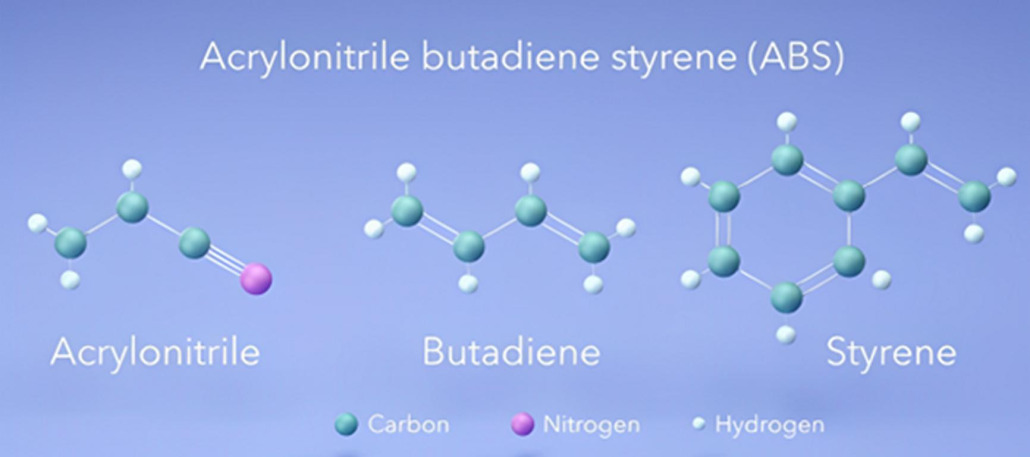
Polycarbonate (PC)
This plastic material is relatively heavier than other plastics. This material could be your best choice when you need a durable solution. It is virtually unbreakable and highly transparent. This material is used in safety glasses and light fixtures. It’s a strong option when transparency and resilience are needed.
Properties: Polycarbonate is heavier than most plastics but is virtually unbreakable and highly transparent. It can withstand high impact and heat, making it suitable for safety applications.
Advantages: It’s one of the strongest transparent plastics available, with excellent heat resistance. It’s also easily molded, allowing for intricate designs in parts and components.
Applications:
Safety Equipment: Used for safety glasses, helmets, and shields due to its shatter-resistant quality.
Optical Media: Common in lenses and DVDs because of its clarity.
Construction and Lighting: Used in skylights, lighting fixtures, and bulletproof glass for durability and transparency. Go to polycarbonate injection molding and Polycarbonate vs Acrylic pages to know more about this PC plastic material.
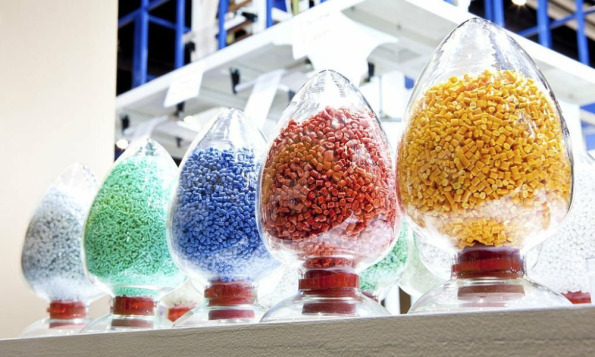
Nylon (PA)
Nylon is a plastic material with excellent strength and flexibility. It is also very resistance to wear and abrasion. Available in different grades (Nylon 6, Nylon 6/6, etc.), each with specific properties, it is widely used in industrial applications requiring toughness. It can also handle high temperatures.
Properties: Excellent strength, flexibility, abrasion resistance, and wear resistance. Nylon can withstand high temperatures and provides good chemical resistance.
Advantages: Nylon’s high durability and heat resistance make it a top choice for mechanical parts, while its low friction makes it suitable for gears and bearings.
Applications:
Mechanical Components: Often used in gears, bearings, bushings, and other wear-prone parts due to its strength and durability.
Textiles: Common in fabrics due to its strength and resilience, often used in outdoor gear and apparel.
Automotive: Used in engine components, fuel tanks, and under-the-hood parts due to its heat resistance. Go to nylon injection molding page to know more.
Every single plastic provides specific advantages that make it ideal for particular applications. Selection depends on factors like strength requirements, environmental conditions, aesthetic preferences, and manufacturing costs. This guide helps in understanding which plastic might be best suited for various product requirements across different industries, from consumer goods to industrial components.

Plastic Injection Molding services
A typical plastic injection molding factory can offer you unique services. Each of these services might benefit you in your business. This section will familiarize you with a few plastic injection molding services.
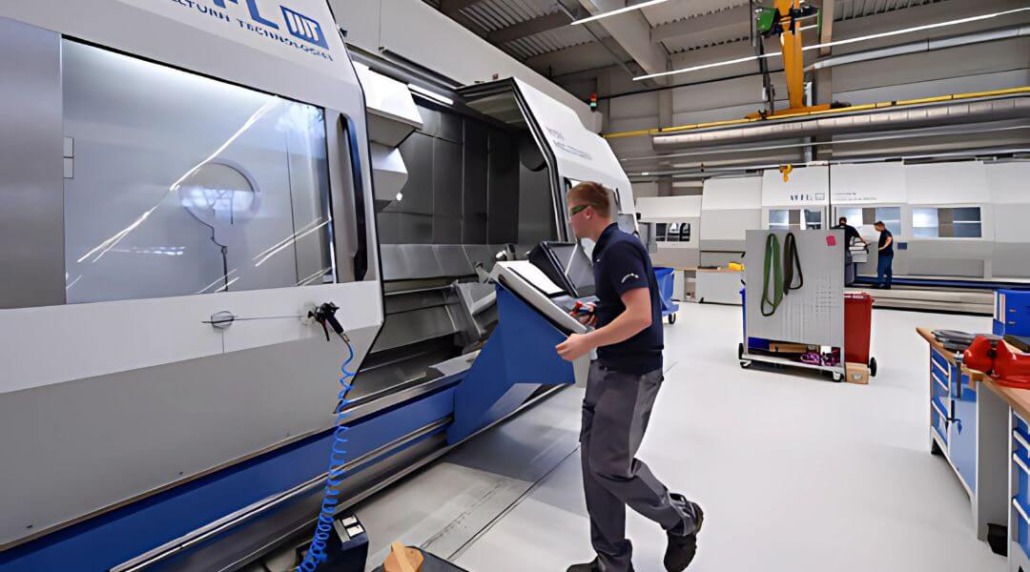
Service #1 Design and Engineering Support
Designing and engineering support are crucial parts of mold and product design. A perfect injection mold can ensure effective injection and the highest quality of the products. Every mold manufacturing company specializes in this to meet specific customer demands. The engineering team collaborates with clients to optimize part designs.
This way, they can ensure good manufacturability and the efficiency of the whole process. They also evaluate the initial design and suggest changes to save time and reduce costs.
DFM is a term used to manufacture plastic injection molds. Design for manufacturability focuses on how easy or difficult a design is to manufacture. It helps identify potential issues early in the process. By implementing DFM principles, designers can reduce production hiccups. You will know this when you deal with the actual injection mold design process.
Service #2 Custom Mold Making
Custom mold making is another primary service of an injection molding company. To launch new plastic products, you must start by creating a custom plastic injection mold.
The mold-making process starts with the design and engineering steps. What shape do you need? How thick should the walls be? These questions guide the mold design steps.
Several other factors also play a crucial role here. First is the material choice. As mentioned already, injection molds are typically made of high-quality tool steels. When making the molds, tolerance is the most critical parameter. Therefore, the manufacturing method must be wisely chosen.
The two most popular injection mold-making methods are CNC machining and casting. CNC machining can be of various types. Based on your design, the CNC method varies. Sometimes, you may need multiple CNC machining methods. For instance, CNC milling creates grooves, holes, and inner shapes. Other CNC methods include CNC turning, boring, drilling, and more.
Metal casting is another method of making injection mold cavity or core, this is specially used in plastic doll toys related products. It is pretty complex and requires careful consideration to make any type of plastic injection molds. CNC machining and EDM (electric discharge machining) are two popular manufacturing process of creating plastic injection molds.
Service #3 Custom Plastic Parts
You might not have the facility to install custom molds. On the other hand, making such facilities might need high costs. Because of this, most injection molding manufacturers also offer to make various custom plastic parts. This way, you can save a lot of investment costs and make money faster, you only need to buy the injectino molds and send your molds to your plastic injection molding supplier, they will make all of custom palstic products base on your customized injection mold.
This process also starts with a clear design. Once the mold is ready, plastic is injected at high pressure into the mold. As the plastic cools and solidifies, the part takes shape. You already know the benefits and detailed manufacturing process.
Service #4 Quality Control and Testing
A plastic injection molding company offers testing and quality control services in addition to the above three services.
Quality control is crucial in injection molding. It’s the safety net that catches upcoming issues when they happen. Various quality control processes might be needed depending on the mold and its products.
Dimensional checks are one of the first lines of testing. This process measures parts against specified tolerances. Are they the right size? Do they fit together as they should? If not, the engineers make necessary adjustments before mass production. Strength testing is the next testing method. This testing method ensures that parts can withstand their intended use. Besides, there are other tests like surface finishing, pressure testing, spur testing, defects testing, and many more.
Frequently Asked Question
How Much Does Injection Molding Cost?
The cost of injection molding generally varies based on design and size—the average ranges from $1000 to $5000. If you need larger molds, the cost might be higher. The cost of injection-molded plastic parts, on the other hand, depends on the type of material. PC plastic is generally more expensive than PVC or ABS.
What Is The Problem With The Injection Molding Process?
Every process has its hiccups, and injection molding is no exception. Common problems include warping, which occurs when the part cools unevenly.
Flash is another problem with the injection molding process. It is the excess material that seeps out of the mold. Have you seen unwanted edges on your plastic parts? If yes, then it’s a sign of flash. In contrast, shorts happen when the mold doesn’t fill completely.
How Long Does It Take to Make A Plastic Mold?
The time it takes to create a plastic mold can range from a few weeks to several months. The specific time is not fixed. It all depends on the complexity and the specifics of your project.
How Do I Add Texture to The Mold?
Adding texture to a mold can improve your product’s look. It’s all about aesthetics and function. There are several methods to do it. One of the popular ways is etching, which creates patterns on the mold’s surface before it’s used. Another option is laser engraving.

Final Words
Plastic injection molding is one of the most popular plastic manufacturing processes. It is an efficient way to make complex, high-precision plastic parts. Throughout this article, we talked about this process, especially plastic injection molding.
We are among the top 10 plastic injection molding companies in China, specializing in plastic injection mold and injection molding manufacturing, and we export plastic parts from China to various contries of the world. Over 40 happy customers have provided us with the best quality, and they are fully satisfied by our quality and service. You are welcome if you need our support. We sincerely hope we could service you in the near future, and you will be surely happy as well as our other happy customers.
The production of thermoplastic plastic products involves a variety of commercial methods. Each has its own specific design requirements as well as limitations. Usually, part design, size, and shape clearly determine the best process. Occasionally, the part concept lends itself to more than one process. Because product development differs depending upon the process, your design team must decide which process to pursue early in product development.
This section briefly explains the common processes used for thermoplastics from Bayer Corporation. Today, many companies purchase injection-molded parts from injection molding companies in China. If you need injection molded parts for your business, you need to really think about this.
The above-described injection molding process uses an injection molding machine to manufacture plastic products. There are two main parts to the machines: the injection unit and the clamping unit. Please visit our injection molding section for further information.
Are you in need of injection molding, or are you seeking a China-based injection mold partner to create plastic molds and manufacture your plastic molded parts? Send us an email, and we will reply to you within two working days.
We are one of the top 10 plastic injection molding companies in China that provides custom injection mould and injection moulding manufacturing services for a variety of plastic products around the world. We offer part design, mold design, PCB design, prototypes, mold making, massive production, testing, certificates, painting, plating, silkscreening, printing, assembly, and delivery, all in one-stop services.
Do you know the name of the process by which most plastic-solid materials are produced? It is called injection moulding. It is one of the best molding processes to make millions of injection-molded parts in a very short time. However, the initial injection mold tooling cost is pretty high compared to other machining methods, but this injection tooling cost will be recovered by the large production later, and this process has a low or even no waste rate.
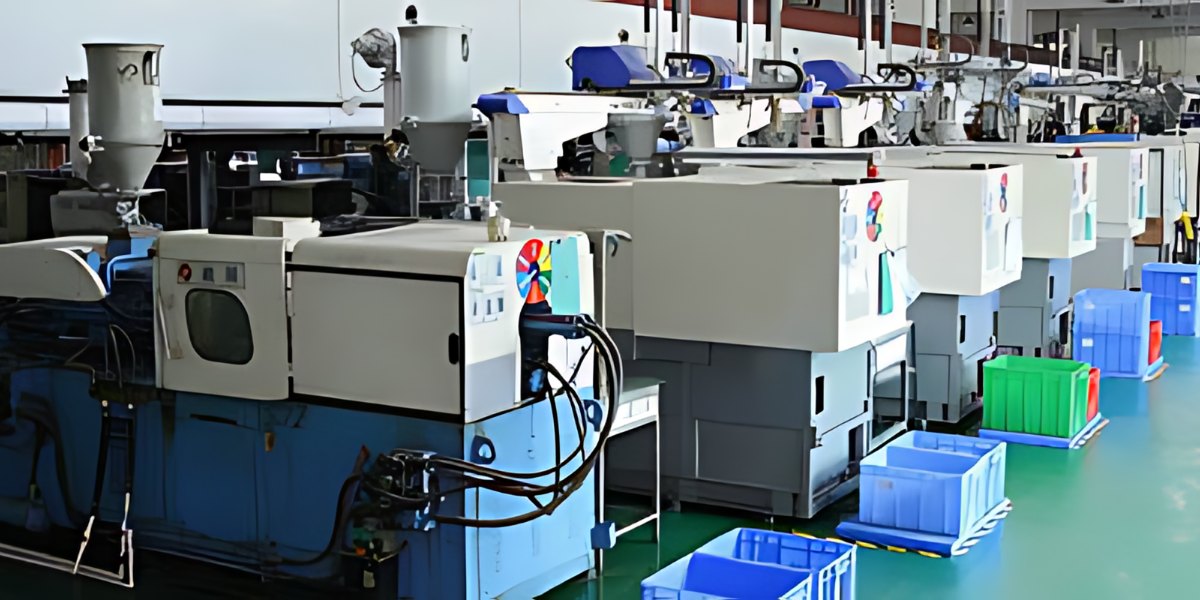
What is injection molding
Injection molding (or injection moulding) is a manufacturing technology for producing products from plastics. Injecting the molten plastic resin at high pressure into an injection mould, which the mold is made according to the desired part shape, which was created by a designer using some CAD design software (such as UG, Solidworks, etc.).
The mould is made by a mold company (or mold maker) from metal material or aluminum and precision-machined to form the features of the desired part by some high-tech machines like CNC machines, EDM machines, lather machines, grinding machines, wire-cutting machines, etc., step by step to make the final mould cavity base on exactly the desired part shape and size, which we called an injection mold.
The injection moulding process is widely used for producing a variety of plastic products, from the smallest component to the big bumpers of cars. It is the most common technology to produce molding products in the world today, with some commonly made products including food containers, buckets, storage bins, house cooking equipment, outdoor furniture, automotive components, medical components, molding toys, and more.
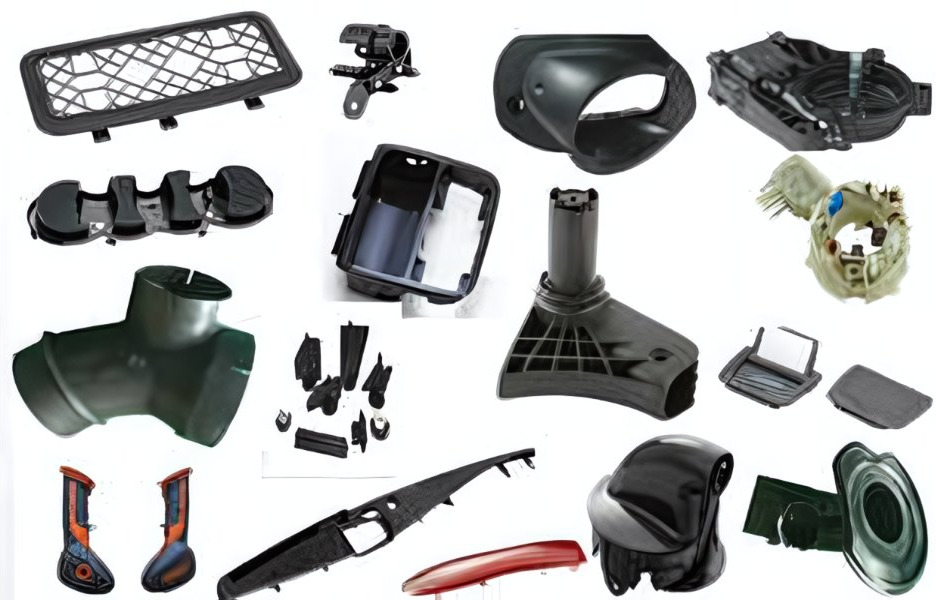
Types of Injection Moulding – Basically 7 types of injection molding process as below
- Reaction injection molding
- Liquid injection molding
- Gas-assist injection molding
- Co-injection molding
- 2-Shot Injection Molding (or double injection molding)
- Fusible core injection molding
- Rapid injection molding
Injection moulding equipment
Injection molding machine
Injection molding machines, normally called injection presses, fasten our custom-made injection mold in the machine. The injection machine is rated by tonnage, which indicates the amount of clamping force that the press can generate. This clamping force keeps the mold closed during the injection molding process. There are various specifications for injection molding machines, from less than 5 tons to 6,000 tons or even bigger.
In general, the basic injection molding machine consists of a mold system, control system, injection system, hydraulic system, and Pinpin system. The tonnage clamp and shot size are used to identify the dimensions of a thermoplastic injection molding machine, which is a major factor in the overall process. Another consideration is the thickness of the mold, pressure, injection rate, the distance between the binding rod, and the screw design.
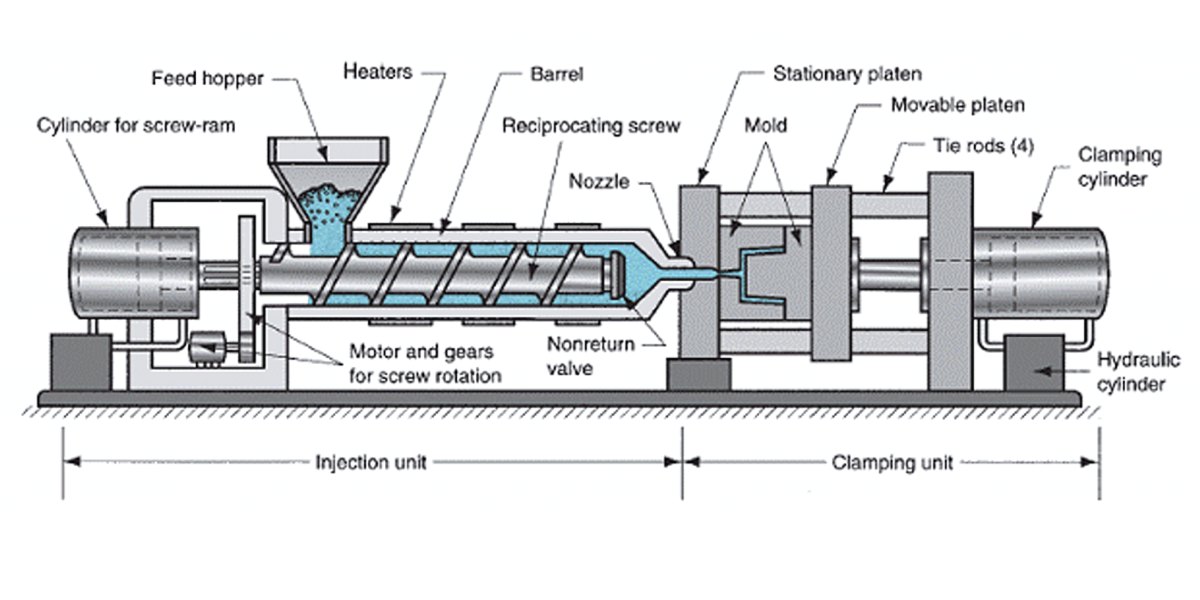
Horizontal Injection-molding-machine
Horizontal or vertical machines
There are normally two types of injection molding machines: horizontal and vertical molding machines.
This means molding machines fasten the mold in either a horizontal or vertical position. The majority are horizontal injection molding machines, but vertical machines are used in some niche applications such as cable insert molding, filter injection molding, insert molding, or some special molding process requirements.Some injection machines can produce two, three, or four colored molded parts at one step; we call them double-shot injection molding machines or 2K injection molding machines (more color will be 3K or 4K molding machines).
Clamping unit
Machines are classified primarily by the type of driving systems they use: hydraulic, electric, or hybrid. Hydraulic presses have historically been the only option available to molders until Nissei introduced the first all-electric machine in 1983. The electric press, also known as Electric Machine Technology (EMT), reduces operation costs by cutting energy consumption and also addresses some of the environmental concerns surrounding the hydraulic press.
Electric injectino molding presses have been shown to be quieter, faster, and have higher accuracy; however, the machines are more expensive. Hybrid injection molding machines take advantage of the best features of both hydraulic and electric systems. Hydraulic machines are the predominant type in most of the world, with the exception of Japan.
Final sumrize for injection molding machine: Injection molding machine converts raw plastic granules or granules into final mold parts using thermoplastic smelting, injection, conditioning, and cooling cycles.
Injection Mold- Types of injection molds
Simply explain that the injection mold is custom made of the desired part shape by cutting the steel or aluminum and producing the mold that can be used in the injection molding machine, which we called injection mold or plastic injection mold. Go to our plastic molding section to learn more about plastic injection mold manufacturing. But making injection mould actually not easy; you need to have a professional team (a mold maker, a mold designer) and mold manufacturing equipment like CNC machines, EDM machines, wire-cutting machines, etc.
There are two main types of injection molds: cold runner mold (two plate and three plate designs) and hot runner molds (the more common of the runner-less molds). The significant difference is the presence of sprue and runner with every molded part in the cold runner type. This extra molded component must be separated from the desired molded par;, the hot runner basically does not have any runner wasteore small runner waste.
Cold runner mold
Developed to provide for injection of thermoset material either directly into the cavity or through sprue and a small sub-runner and gate into the mold cavity, there are basically two types of the cold runner which mostly used in the mold industry, two plate mold and Three plate mold.
Two plate mold
The conventional two-plate mold consists of two halves fastened to the two platens of the molding machine’s clamping unit. When the clamping unit is opened, the two mold halves open, as shown in (b). The most obvious feature of the mold is the cavity, which is usually formed by removing metal from the mating surfaces of the two halves. Molds can contain a single cavity or multiple cavities to produce more than one part in a single shot. The figure shows a mold with two cavities. The parting surfaces (or parting line in a cross-sectional view of the mold) are where the mold opens to remove the part(s).
In addition to the cavity, there are other features of the mold that serve indispensable functions during the molding cycle. The mold must have a distribution channel through which the polymer melt flows from the nozzle of the injection barrel into the mold cavity. The distribution channel consists of (1) a sprue, which leads from the nozzle into the mold; (2) runners, which lead from the sprue to the cavity (or cavities); and (3) gates that constrict the flow of plastic into the cavity. There are one or more gates for each cavity in the mold.
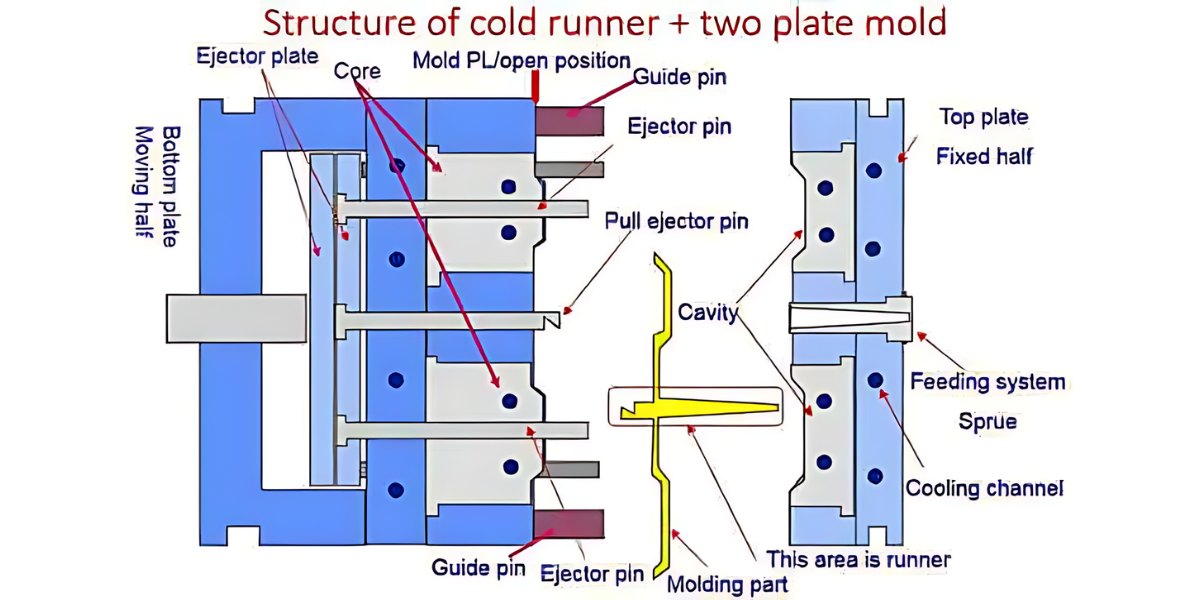
Three plate mold
The two-plate mold is the most common mold in injection molding. An alternative is a three-plate injection mold. There are advantages to this mold design. First, the flow of molten plastic is through a gate located at the base of the cup-shaped part rather than at the side. This allows for a for a more even distribution of melt along the sides of the cup. In the side gate design of the two-plate, the plastic must flow around the core and join on the opposite side, possibly creating a weakness at the weld line.
Second, the three-plate mold allows more automatic operation of the molding machine. As the mold opens, it divides into three plates with two openings between them. This forces the disconnection of runners and parts, which drop by gravity (with possible assistance from blown air or a robotic arm) into different containers beneath the mold.
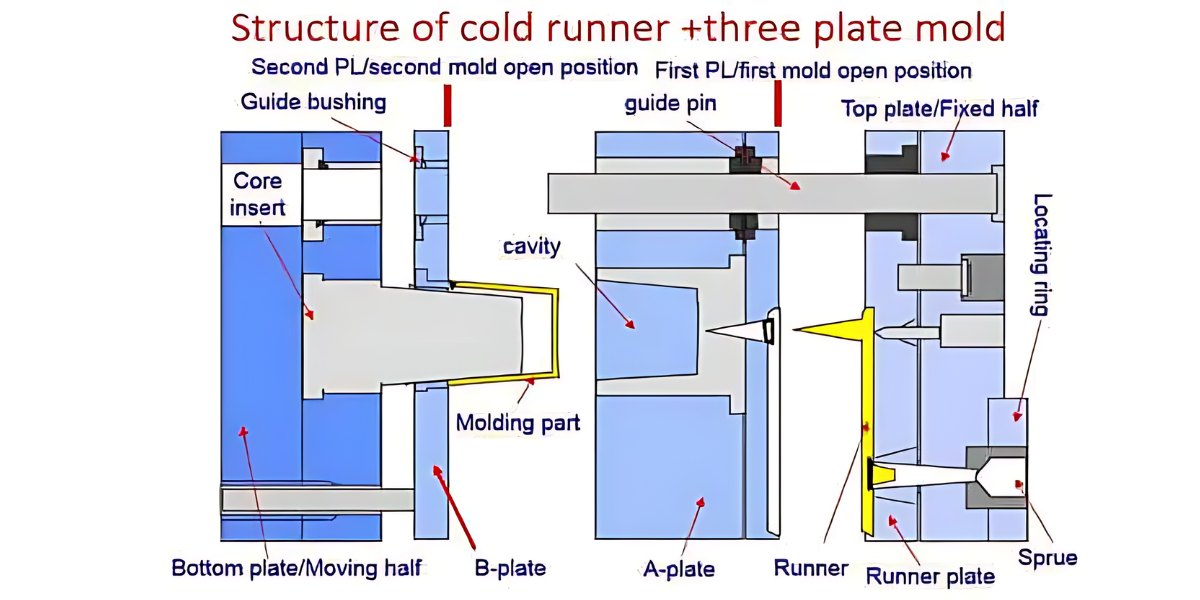
Hot Runner Mold
Hot-runner molding has parts that are physically heated. These types of molding help transfer the molten plastic quickly from the machine, directly feeding it into the mold cavity. It can also be known as the runner-less mold. The hot runner system is very useful for some of the high volumes of products that will save huge production costs by using the hot runner mold system. The sprue and runner in a conventional two-plate or three-plate mold represent waste material.
In many instances, they can be ground and reused; however, in some cases, the product must be made of “virgin” plastic (original raw plastic material) or there is multiple cavity mold (such as 24 cavities or 48 cavities, 96 cavities, 128 cavities, or even more cavities). The hot-runner mold eliminates the solidification of the sprue and runner by locating heaters around the corresponding runner channels. While the plastic in the mold cavity solidifies, the material in the sprue and runner channels remains molten, ready to be injected into the cavity in the next cycle.
Type of hot runner system.
Basically, there are two types of hot runner systems: one called hot sprue mold (without the manifold plate and hot runner plate), and one called hot runner mold (with the manifold plate and hot runner plate).
Hot sprue mold (without the manifold plate and hot runner plate) uses the hot nozzle (sprue) to feed the material into the mold cavity, either directly or indirectly.
The hot runner mold (with the manifold plate and hot runner plate) means the hot runner system has the hot runner plate, manifold plate, and sub-hot runner sprue. The below pictures are simple explanations for two types of hot runner systems.
Advantages and Disadvantages of Cold Runner Molding
There are a few amazing advantages to cold-runner molding, such as:
- Cold-runner molding is cheaper and easier to maintain.
- You are able to quickly change colors.
- It has a faster cycle time.
- It is more flexible than hot-runner molding.
- The gate locations can easily be changed or fixed.
Although there are many advantages, there are also some disadvantages. The disadvantages of cold-runner molding are:
- You have to have thicker dimensions compared to the hot runner mold.
- You can only use certain types of nozzles, fittings, and manifolds.
- Cold-runner molding can result in slower production time when you remove sprues and runners.
- You must manually separate the runners and parts after molding.
- You may waste the plastic materials if you do not reset after each run.
If you want to know more information, please go to the cold runner mold page to check out more details.
Advantages and Disadvantages of Hot Runner Molding
Hot-runner molding has a few advantages, such as:
- Hot-runner molding has a very quick cycle time.
- You can save production costs by using hot-runner molding.
- Less pressure is needed to inject the molding.
- You have more control over the hot-runner molding.
- Hot-runner molding can fit a wide variety of gates.
- Multiple cavities of mold can be easily filled by using the hot runner system.
The disadvantages of using hot-runner moldings are:
- It is more expensive to make the hot runner mold than the cold runner mold.
- It is difficult to maintain and fix the hot runner mold.
- You are not able to use hot-runner molding on materials that are thermally sensitive.
- You will need to get your machines inspected more often than cold-runner molding machines.
- It is hard to change the colors in the hot runner mold system.
Want to know more information? Welcome to the hot runner mold section.
Injection Moulding Processing?
Injection moulding is one of the best ways to shape plastic products by injecting a thermoplastic material. During the process of injection molding, the plastic material is placed in the injection molding machine and the melt system of the injection unit is used to melt the plastic into the liquid. The liquid material is then high-pressure-injected into a mold (a custom manufacturing mold) that is assembled in that injection molding machine. The mold is made of any metal, such as steel or aluminum. The molten form is then allowed to cool down and set into a solid form.
The plastic material thus formed is then ejected out of the plastic mold. The actual process of plastic molding is just an expansion of this basic mechanism. The plastic is let into a barrel or chamber under gravity or is force-fed. As it moves down, the increasing temperature melts the plastic resin. Then, the molten plastic is forcibly injected into the mold under the barrel with an appropriate volume. As the plastic cools, it solidifies. The injection-molded parts like this have a reverse shape from the mold. A variety of shapes, both 2D and 3D, can be produced by the process.
The process of plastic molding is cheap due to the simplicity involved, and the quality of the plastic material is modifiable by changing the factors involved in the custom injection molding process. The pressure of injection can be changed to change the hardness of the final product. The thickness of the mold also governs the quality of the article produced.
The temperature for melting and cooling determines the quality of the plastic formed. ADVANTAGES The major advantage of injection molding is that it is very cost-effective and fast. Apart from this, unlike the cutting processes, this process rules out any undesired sharp edges. Also, this process produces smooth and finished products that require no further finishing. Check below for the detailed advantages and disadvantages.
Advantages of injection moulding
Although injection molding is used by many different companies, and there is no doubt this is one of the most popular methods to produce injection molding products, there are some advantages to using it, such as:
- Precision and aesthetics—because in this injection molding process you can make your plastic part with any shape and surface finish (texture and high gloss finishing), some of the special surface finishing can still be met by the secondary surface finishing process. The injection molding part is the repeatability of their shapes and dimensions.
- Efficiency and speed: a single production process, even for the most complex products, lasts from a few to several dozen seconds.
The possibility of full automation of the production process, which in the case of companies dealing with the production of plastic components translates into low production effort and the possibility of mass production,. - Ecology: because, compared to metalworking, we are dealing with a significant reduction in the number of technological operations, less direct energy and water consumption, and low emissions of compounds harmful to the environment.
Plastics are materials that, although known relatively recently, have even become indispensable in our lives, and thanks to increasingly modern production processes from year to year, they will contribute even more to saving energy and other natural resources.
Disadvantages of injection molding
- The high cost of injection molding machines and often the cost of tooling (molds) that equals it result in extended depreciation time and high costs of starting production.
- Due to the above, injection technology is only cost-effective for mass production.
- The need for high-qualification technical supervision employees who must know the specifics of injection molding processing.
- The need for high technical requirements for injection mold making
- The need to maintain narrow tolerances for processing parameters.
- A long time of preparation for the production due to the labor-intensive implementation of the injection molds.
Injection molding cycle time
The basic injection cycle time includes mold close, injection carriage forward, plastics filling time, metering, carriage retracts, holding pressure, cooling time, mold open, and eject part(s).
The mold is closed shut by the injection molding machine, and the melted plastic is forced by the pressure of the injection screw to inject into the mold. The cooling channels then assist in cooling the mold, and the liquid plastics become solid into the desired plastic part. The cooling system is one of the most important parts of the mold; inappropriate cooling can result in distorted molding products, and the cycle time will be increased, which will increase the injection molding cost as well.
Molding Trial
When the injection plastic mold has been made by the mold maker, the first thing we need to do is do the mold trial. This is the only way to check the mold quality to see if it was made according to the custom requirement or not. To test the mold, we normally fill the plastics with the molding step by step, using short-shot filling at first, and increasing the material weight little by little until the mold is 95 to 99% full.
After meeting this status, a small amount of holding pressure will be added and holding time increased until the gate freeze-off has occurred. Holding pressure is then increased until the molding part is free of sink marks and the part weight has been stable. Once the part is good enough and has passed any specific technical tests, a machine parameter sheet needs to be recorded for massive production in the future.
Plastic injection molding defects
Injection molding is a complex technology, and problems may happen every time. A new custom made of an injection mold has some issues, which is very normal. To solve the mold issue, we need to fix and test the mold several times. Normally, two or three trials can completely solve all the issues, but in some cases, only a one-time mold trial can approve the samples. And finally, all of the issues are solved completely. Below are most of the injection molding defects and the troubleshooting skills to solve those issues.
Issue No. I: Short shot defects- What is a short shot issue?
When injecting material into the cavity, molten material does not completely fill the cavity, resulting in the product lacking material. This is called short molding or short shot, as shown in the picture. There are lots of reasons to cause short shot issues.

Fault Analysis and Method for Correction the defects
- Improper selection of injection molding machine: When choosing plastic injection machines, the maximum shot weight of the plastic injection machine must be greater than the weight of the product. During verification, the total injection volume (including the plastic product, runner, and trimming) shall not be more than 85% of the plasticizing capacity of the machine.
- Insufficient supply of material: the bottom of the feed position might have “bridging the hole” phenomena. The shot stroke of the injection plunger should be added to increase the supply of material.
- Poor flow factor of raw material: improve mold injection system, for example, by proper design of runner location, by enlarging gates, runner, and feeder size, and by using a bigger nozzle, etc. In the meantime, the additive can be added to the raw material to improve the flow rate of the resin or change the material to have a better flow rate.
- Overdose of using the lubricant: reduce the lubricant and adjust the gap between the barrel and injection plunger to recover the machine, or fix the mold so that there is no need for any lubricant during the molding process.
- Cold foreign substances blocked the runner. This issue normally happens with hot-runner systems. Dismount and clear the nozzle of the hot runner tip, or enlarge the cold material cavity and runner cross-section area.
- Improper design of injection feeding system: When designing the injection system, pay attention to gate balance; the product weight of each cavity should be in proportion to the gate size, so that each cavity can be fully filled simultaneously, and gates should be positioned in thick walls. A balanced separate runners scheme can also be adopted. If the gate or runner is small, thin, or long, the molten material pressure will be reduced too much during feeding, and the flow rate will be blocked, which will result in poor filling. To solve this problem, the cross-sections of the gate and runner should be enlarged, and multiple gates should be used when necessary.
- Lack of venting: check if there is a cold-slug well or if the position of the cold-slug well is correct. For mold with a deep cavity or deep ribs, venting slots or venting grooves should be added at positions of short molding (end of feeding area). Basically, there are always venting grooves on the parting line; the size of the venting grooves can be 0.02-0.04mm and 5-10mm in width, 3mm close to the sealing area, and the venting opening should be at the end of filling the position.
When using raw materials with excessive moisture and volatile content, a large amount of gas (air) will also be generated, causing air trap issues in the mold cavity. In this case, raw materials should be dried and cleared of volatile substances. In addition, during the injection process operation, poor venting can be addressed through increasing mold temperature, low injection speed, reducing injection system obstruction and mold clamping force, and enlarging gaps between molds. But the short shot issue happens to the deep rib area. To release the air out, you need to add a venting insert to solve this air trap and short shot issues. - The mold temperature is too low. Before starting molding production, the mold should be heated up to the required temperature. In the beginning, you should connect all of the cooling channels and check if the cooling line is working well, especially for some special materials like PC, PA66, PA66+GF, PPS, etc. The perfect cooling design is a must for those special plastic materials.
- Molten material temperature is too low. In a proper molding process window, the temperature of the material is in proportion to the filling length. Low-temperature molten material is poor in fluidity, and the filling length is shortened. It should be noted that after the feed barrel is heated to the required temperature, it should stay constant for a while before starting molding production.
In the event that low-temperature injection must be used to prevent molten material from being resolved, the injection cycle time can be prolonged to overcome the short shot. If you have a professional molding operator, he should know this very well. - Nozzle temperature is too low. When open mold, the nozzle should be part away from the mold spure to reduce the influence of mold temperature on the nozzle temperature and keep the nozzle temperature within the range of what the molding process requires.
- Insufficient injection pressure or holding pressure: injection pressure is close to a positive proportion to the filling distance. The injection pressure is too low, the filling distance is short, and the cavity cannot be fully filled. Increasing the injection pressure and holding pressure can improve this issue.
- Injection speed is too slow. Mold filling speed is directly related to injection speed. If injection speed is too low, filling of molten material is slow while slow-flowing molten is easy to cool, hence the flow properties further decrease and result in a short injection. For this reason, the injection speed should be enhanced properly.
- Plastic product design is not reasonable. If the wall thickness is out of proportion to the length of the plastic product, the product shape is very complex, and the forming area is large, melt material is easily blocked at the thin wall of the product, leading to insufficient filling. Therefore, when designing the shape and structure of the plastic products, note that wall thickness is directly related to melting limit filling length. During injection molding, product thickness should range between 1-3 mm and 3-6 mm for large products. Generally, it is not good for injection molding if the wall thickness is over 8 mm or less than 0.4 mm, so this kind of thickness should be avoided in design.
Issue No. II: Trimming (Flashing or burrs) Defects
I. What is the flashing or Burrs?
When extra plastic melt material is forced out of the mold cavity from the mold joint and forms a thin sheet, trimming is generated. If the thin sheet is large, it is called flashing.

Molding Flash or burrs
II. Fault Analysis and Method for Correction
- Mold clamping force is not sufficient. Check whether the booster is overpressurizing and verify whether the product of the projected area of the plastic part and the forming pressure exceed the clamping force of the equipment. Forming pressure is the average pressure in the mold; normally, it is 40 MPa. If the calculation product is larger than the mold clamping force, it indicates that the clamping force is insufficient or the injection positioning pressure is too high. In this case, the injection pressure or section area of the injection gate should be reduced; pressure keeping and pressurization time can also be shortened; injection plunger strokes can be reduced; the number of injection cavities can be reduced; or a mold injection machine with a larger tonnage can be used.
- The material temperature is too high. The temperature of the feed barrel, nozzle, and mold should be decreased properly to reduce the injection cycle. For melts of low viscosity, like polyamide, it is difficult to solve overflow flashing defects by simply changing injection molding parameters. To solve this issue completely, fixing the mold is the best way, like doing better mold fitting and making the parting line and shot-off area more precise.
- Mold defect. Mold defects are the main reason for overflow flashing. The mold must be carefully examined and the mold parting line re-verified to ensure the pre-centering of the mold. Check whether the parting line fits well, whether the gap between sliding parts in the cavity and core is out of tolerance, whether there is adhesion of foreign matter on the parting line, whether the mold plates are flat and whether there is bending or deformation, whether the distance between mold pate is adjusted to fit the thickness of the mold, whether the surface mold block is damaged, whether the pull rod is deformed unevenly, and whether the venting slot or grooves is too large or too deep.
- Improperness of the molding process. If injection speed is too high, injection time is too long, injection pressure in the mold cavity is unbalanced, mold filling speed is not constant, or there is overfeeding of material, an overdose of lubricant can lead to flashing; therefore, corresponding measures should be taken according to the specific situation during operation.
Issue No. III. Welding Line (Joint Line) Defects
I. What is the welding line defect?

Welding line
When filling the mold cavity with molten plastic material, if two or more flows of molten material have cooled down in advance before confluence t the joint area, the flows will not be able to totally integrate and a liner is produced at the confluence, thereby a welding line is formed, also called joint line
II. Fault Analysis and Method for Correction
- The material temperature is too low. Low-temperature molten material flows have poor confluence performance, and the welding line is easily formed. If welding marks appear at the same position on both the interior and exterior of a plastic product, it is usually inappropriate welding caused by the low temperature of the material. To address this problem, the feeding barrel and nozzle temperatures can be properly increased, or the injection cycle can be prolonged to increase the material temperature. In the meantime, the coolant flow inside the mold should be regulated to properly increase the mold temperature.
Generally, the strength of the plastic product welding line is relatively low. If the position of the mold with the welding line can be partially heated to partially increase the temperature at the welding position, the strength at the welding line can be enhanced. When a low-temperature injection molding process is used for special needs, injection speed and injection pressure can be increased to improve confluence performance. A small dosage of lubricant can also be added to the raw material formula to increase molten flow performance. - Mold Defect. The fewer numbers of the gate should be adopted, and the position of the gate should be reasonable to avoid inconsistent filling speed and interruption of molten flow. Where possible, a one-point gate should be adopted. To prevent low-temperature molten material from generating a welding mark after being injected into the mold cavity, lower the mold temperature and add more cold water to the mold.
- Poor mold venting solution. Check whether the venting slot is blocked by solidified plastic or another substance at first (especially some glass fiber material), and check whether there is a foreign substance at the gate. If there are still carbonation spots after removing the extra blocks, add a venting groove at the flow convergence in the mold or change the gate location. Reduce the mold clamping force and increase venting intervals to speed up the convergence of material flows. In terms of the molding process, reducing material temperature and mold temperature, shortening high-pressure injection time, and decreasing injection pressure can be taken.
- Improper use of release agents. In injection molding, usually, a small quantity of release agent is evenly applied at the thread and other positions that are not easy to demold. In principle, the use of the release agent should be reduced as much as possible. In massive production, you should never use a release agent.
- The structure of plastic products is not reasonably designed. If the wall of the plastic product is too thin, the thickness differs greatly, or there are too many inserts, it will cause poor welding. When designing a plastic product, it shall be ensured that the thinnest part of the product must be greater than the minimum wall thickness allowed during forming. In addition, reduce the number of inserts and make the wall thickness as uniform as possible.
- The welding angle is too small. Each kind of plastic has its own unique welding angle. When two flows of molten plastic converge, the welding mark will appear if the converging angle is smaller than the limit welding angle and will disappear if the converging angle is bigger than the limit welding angle. Usually, the limit welding angle is around 135 degrees.
- Other causes. Different degrees of poor welding can be caused by the use of raw materials with excessive moisture and volatile content, oil stains in the mold that are not cleaned up, cold material in the mold cavity or uneven distribution of fiber filler in the molten material, an unreasonable design of the mold cooling system, fast solidification of the melt, a low temperature of the insert, a small nozzle hole, an insufficient plasticizing capacity of the injection machine, or a large pressure loss in the plunger or barrel of the machine.
To solve these problems, different measures, such as pre-drying of raw materials, regular cleaning of mold, changing the design of mold cooling channels, controlling the flow of cooling water, increasing the temperature of inserts, replacing nozzles with larger apertures, and using injection machines with larger specifications, can be taken in the process of operation.
Issue No. IV: Warp Distortion – What is warp distortion?
Due to internal shrinkage of the product is inconsistent, the internal stress is different and distortion occurs.
Fault Analysis and Method for Correction
1. The molecular orientation is unbalanced. In order to minimize warp distortion caused by diversification of molecular orientation, create conditions to reduce flow orientation and relax orientation stress. The most effective method is to reduce molten material temperature and mold temperature. When this method is used, it is better to combine it with heat treatment of the plastic parts; otherwise, the effect of reducing molecular orientation diversification is often of short duration. The method of heat treatment is: after demoulding, keep the plastic product at a high temperature for some time and then cool to room temperature gradually. In this way, the orientation stress in the plastic product can be largely eliminated.
2. Improper cooling. When designing a plastic product structure, the cross-section of each position should be consistent. Plastic must be kept in the mold for a sufficient time for cooling and forming. For the design of a mold cooling system, cooling pipelines should be at positions where the temperature is easy to rise and the heat is relatively concentrated. As for the positions that easily cool down, gradual cooling should be adopted to ensure balanced cooling of each position of the product.
3. The gating system of mold is not properly designed. When determining the gate position, be aware that the molten material will not directly impact the core, and be sure the stress on both sides of the core is the same. For large flat rectangular plastic parts, a membrane gate or multi-point gate shall be used for resin raw materials with wide molecular orientation and shrinkage, and a side gate shall not be used; for ring parts, a disk gate or wheel gate shall be used, and a side gate or pinpoint gate shall not be used; for housing parts, a straight gate shall be used, and a side gate shall not be used as far as possible.
4. The demolding and venting system is not properly designed. In-mold design, draft angle, position, and the number of ejectors should be reasonably designed to improve mold strength and positioning accuracy. For small and medium-sized molds, anti-warping molds can be designed and made according to their warping behavior. In respect of mold operation, ejection speed or ejection stroke should be properly reduced.
5. Improper operation process. The process parameter shall be adjusted according to the actual situation.
Issue No. V: Sink Mark Defects – What is the sink mark?
Sink marks are unevenly shrinking of the surface caused by the inconsistent wall thickness of the plastic product.
Fault Analysis and Method for Correction
- The injection molding condition is not properly controlled. Properly increase injection pressure and speed, increase molten material compression density, prolong injection and pressure-keeping time, compensate for the sinking of the molten, and increase the buffering capacity of injection. However, the pressure should not be too high; otherwise, the convex mark will appear. If sink marks are around the gate, prolonging the pressure keeping time can eliminate the sink marks; if sink marks are at the thick wall, prolonging the cooling time of the plastic product in the mold; if sink marks around the insert are caused by partial shrinkage of molten, the main reason is that the temperature of the insert is too low; try to increase the temperature of the insert to eliminate the sink marks; if sink marks are caused by insufficient material feeding, increase the material. Besides all of this, the plastic product must be fully cooled in the mold.
- Mold defects. According to the actual situation, properly enlarge the gate and runner cross-section, and the gate should be in a symmetrical position. The feed inlet should be in the thick wall. If sink marks appear away from the gate, the cause usually is that the flow of molten material is not smooth at some position of the mold, which hampers the transmission of pressure. To solve this problem, enlarge the injection system to allow the runner to extend to the position of the sink marks. For products with thick walls, a wing-type gate is preferred.
- Raw materials cannot meet molding requirements. For plastic products with high finish standards, resin with low shrinkage shall be used, or the appropriate dosage of lubricant can also be added to the raw material.
- Improper design of product structure. The wall thickness of the product shall be uniform; if the wall thickness differs a lot, the structure parameter of the injection system or the wall thickness shall be adjusted.
Issue No. VI: Flow Mark-What is Flow Mark?
Flow mark is a linear trace on the surface of a molding product that shows the flow direction of molten material.
Fault Analysis and Method for Correction
- Ring-shaped flow marks on the surface of the plastic part with the gate as the center are caused by poor flow motion. To address this kind of flow mark, increase the temperature of the mold and nozzle, increase the injection rate and filling speed, prolong the pressure-keeping time, or add a heater at the gate to raise the temperature around the gate. Appropriately expanding the gate and runner area can also work, while the gate and runner section is preferably circular, which can guarantee the best filling. However, if the gate is in the weak area of the plastic part, it will be square. In addition, a large cold-slug well should be set at the bottom of the injection port and at the end of the runner; the greater the influence of material temperature on the flow performance of the melt, the more attention should be paid to the size of the cold-slug well. The cold-slug well must be set at the end of the melt flow direction from the injection port.
- Whirl flow marks on the surface of the plastic part are caused by the unsmooth flow of molten material in the runner. When the molten material flows from the runner with a narrow section to the cavity with a larger section or the mold runner is narrow and the finish is poor, the material flow is easy to form turbulence, resulting in a whirl flow mark on the surface of the plastic part. To address this kind of flow mark, reduce injection speed appropriately or control the injection speed in slow-fast-slow mode. The mold gate shall be in the thick wall and preferably in the form of a handle type, a fan type, or a film type. The runner and gate can be enlarged to reduce material flow resistance.
- Cloud-like flow marks on the surface of the plastic part are caused by volatile gas. When ABS or other copolymerized resins are used, if the processing temperature is high, the volatile gas produced by the resin and lubricant will form cloud-like ripple marks on the surface of the product. In order to solve this problem, it is necessary to reduce the temperature of the mold and barrel, improve the venting of the mold, reduce the material temperature and filling speed, enlarge the gate section properly, and consider changing the type of lubricant or reducing the use of lubricant.
Issue No. VII: Glass fiber streaks – What is Glass fiber streaks
Surface Appearance: Plastic molding products with glass fiber have various surface defects, such as dim and dreary in color, coarse in texture, and metal bright spots, etc. These are especially obvious in the convex part of the material flow area, close to the joint line where the fluid meets again.
Physical cause
If the injection temperature and the mold temperature are too low, the material containing glass fiber tends to solidify fast on the mold surface, and the glass fiber will not melt in the material again. When two flows meet, the orientation of glass fiber is in the direction of each flow, which will lead to irregular surface texture at the intersection, resulting in the formation of joint seams or flow lines.
This type of defect is more obvious if the molted material is not fully mixed in the barrel. For example, if the stroke of the screw is too long, it will cause the undermixed material to also be injected.
Causes related to process parameters and improvements can be identified:
- The injection speed is too low. To increase injection speed, consider using a multi-step injection method like slow-fast mode.
- The temperature of the mold is low; increasing the mold temperature could improve the glass fiber streaks.
- Molten material temperature is too low; increase barrel temperature and screw back pressure to improve.
- The temperature of molten material varies a lot: if the molten material is not fully mixed, increase screw back pressure, reduce screw speed, and use the longer barrel to shorten stroke.
Issue No. VIII: Ejector Marks: What are ejector marks?
Surface Appearance: Stress whitening and stress rising phenomena are found on the side of the product that is facing the nozzle, i.e., where the ejector rod is located on the ejector side of the mold.
Physical cause
If the demoulding force is too high or the surface of the ejector rod is relatively small, the surface pressure here will be very high, causing deformation and eventually whitening at the ejection area.
Causes related to process parameters and improvements can be applied:
- Holding pressure is too high; decrease pressure while keeping pressure.
- Holding pressure time is too long; shorten holding pressure time.
- Holding pressure switch time is too late. advance the pressure-keeping switch
- The cooling time is too short; increasing the cooling time
Causes related to mold design and improvements can be applied:
- The draft angle is not enough; increase the draft angle according to specification, especially in the area of the ejector mark.
- The surface finish is too rough; the mold shall be well polished in the demolding direction.
- A vacuum is formed on the ejection side. Install an air valve in the cor
Conclusion
Due to the specific properties of plastics, injection molding is a very complex technological process; unlike the seemingly related process of metal die casting, it is not a mechanical process but a mechanical-physical one. In the injection molding process, a molded piece is obtained. It is characterized not only by a specific shape but also by a specific structure resulting from the flow of the plasticized material in the mold and the course of its solidification.
Because these processes occur in the form of injection, the designer of this tool must take into account, in addition to typically mechanical issues, issues related to the physical nature of the material transformation. Constructing a rationally working form requires, at the same time, from the designer a thorough knowledge of the technical capabilities of the injection molding machine, because it is a machine with extremely rich possibilities provided by its equipment and numerous work programs.
If you want to know more, please go to our other plastic mold page. If you are looking for injection molding services, you are welcome to send us your requirements for a quotation.
If you have a new project or current project that needs a China injection molding company to support you, we are happy to help. Please call us or send us an email.
A plastic mold maker is a professional manufacturer or company who designs and makes plastic molds used to produce plastic products through an injection molding process. The plastic mold maker uses a variety of methods, machines, and techniques to manufacture plastic molds that are durable, precise, and capable of producing thousands to millions of the same quality plastic products.
Some of the mold manufacturing processes that a plastic mold maker may perform include: mold design, moldflow analysis, CNC machining, EDM machining, lather machining, milling machining, fitting, assembling and testing molds, and making modifications to improve mold performance to get a final perfect mold; all of those jobs are done by the professional plastic mold maker. Plastic mold makers play a crucial role in the manufacturing industries.

What are the Benefits of Using a Plastic Mold Maker?
Use of a plastic mold maker for your manufacturing needs comes with a number of advantages that you should consider.
Firstly, manufacturers of plastic molds are able to produce plastic molds that are extremely exact and that are tailored to your particular design requirements. Your troubles will be resolved as a result of this, as it guarantees that the end product you produce is of high quality and consistent.
Secondly, using a plastic mold maker can also assist cut production costs over the long term, which brings us to our second point. Once the original mold has been constructed, it may be used repeatedly to generate vast quantities of plastic items, which saves both time and money on tooling and setup expenses. Although the initial cost of the plastic mold is significant, it can be used to produce thousands of plastic products.
Furthermore, plastic mold manufacturers have the ability to contribute to the enhancement of production efficiency by expediting the actual manufacturing process. When you use bespoke molds, you are able to make things at a faster rate and with less waste, which ultimately leads to decreased waste and higher production and profitability.

Types of Plastic Molds
There are various kinds of plastic molds available; each of them has special uses. We’ll look at a few of the most often used plastic mold types on the market.
injection molds: injection molds are the type of plastic molds that are utilized in the world of business the most frequently. Manufacturers use them to produce a wide range of plastic products, such as home items, electronic components, and automobile parts. The stationary half of an injection mold and the moving half of the mold simultaneously clamp together during the molding process. We apply high pressure to inject molten plastic into the mold’s cavity, allowing it to cool and harden to take on the desired shape.
Blow molds: Bottles, containers, and tanks are just a few examples of the hollow plastic goods made with blow molds. In order to get the plastic to expand and take on the shape of the mold, air is injected into a parison, which is a hollow tube filled with molten plastic, inside the mold cavity. We can construct blow molds from a variety of materials, including steel, plastic, and aluminum, depending on the need.
Compression Molds: Compression molds produce plastic items with exceptional precision and strength. The mold cavity receives a heated plastic sheet or pellet, which undergoes intense pressure compression to assume the desired shape. Manufacturers widely use compression molds to produce intricately designed products with precise dimensions, like parts for automobiles and aircraft.
Rotational Molds: Also known as rotomolds, these molds create large, hollow plastic objects such as playground equipment, tanks, and containers. The procedure entails heating the mold chamber and turning it in two perpendicular directions so that the molten plastic coats the mold’s internal surface uniformly. Rotational molds are incredibly adaptable and can create intricate shapes with consistent wall thickness.
Thermoforming Molds: Manufacturers use thermoforming molds to create goods with thin plastic walls, such as clamshell containers, packaging trays, and disposable cups. A mechanical plug or vacuum pressure helps form a thermoplastic sheet over a mold cavity after heating it until it becomes malleable. Molds for thermoforming are economical and appropriate for large-scale manufacturing.
Various industries suit different types of custom plastic molds, each with its own unique advantages and limitations. A plastic mold maker can help you choose the best mold according to your project. If you do not know what type of mold you should use, contact us for a quote, and we will offer you a suitable mold type to suit your project.

What is the Process for Making a Plastic Mold?
Typically, the process of creating a plastic mold involves the following simple steps:
Part design: The initial step in creating a plastic mold is to design the part you want to use or sell.
Prototype: After completing the design, it is crucial to test its functionality and make any necessary improvements. This may involve testing the prototype through 3D printing or CNC machining until it functions flawlessly.
Mold Design: The plastic mold maker should begin the mold design as soon as the part design receives approval. The plastic mold maker will use this design to develop and manufacture a mold that precisely shapes the required plastic part.
Machining: Once the mold design is completed and approved by the customer, using CNC (computer numerically controlled) machinery, EDM machining, wire cutting machining, lather machining, polishing, and so on, the mold components are made of metal or other materials, such as coppler, aluminum, etc.
Assembly: After completing the machining process, the machined parts are inserted into the moldbase to form the mold. This could include fastening the components in place with bolts, welding, or other techniques.
Testing: The mold undergoes testing to ensure its functionality and ability to produce the correct plastic part. To improve performance, this can entail modifying or adjusting the mold’s component parts.
Finishing: To ensure the mold meets the necessary standards, it may undergo coating, polishing, or other treatments to prolong its useful life.
Qualification: The mold meets the necessary requirements and can produce high-quality plastic components.
Making a plastic mold is a difficult operation that calls for accuracy, knowledge, and certain tools. A proficient plastic mold maker possesses the required expertise and abilities to guarantee the triumph of your plastic manufacturing procedure.
Mold is a fungus that thrives on a variety of materials. Molds obtain energy by consuming other substances, in contrast to plants, which obtain their nourishment from photosynthesis. For instance, if there is mold on your bread, it is probably eating the bread itself. In a similar vein, it’s possible that the wood and other components in the walls are the source of the mold.
Above are simple mold manufacturing process, making plastic mold is very complex task, if you have any project that need plastic molds, the best options is to find a professiona plastic mold maker to make the molds for you.
If you’re interested in injection plastic mold makers but don’t know where to look for them, you should consider a few specific options. You can be sure that you get the highest quality and value by selecting these specific injection mold maker firms over others, which is obviously essential to everyone.

Bring into Play the Use of Plastic Mold Makers:
The Plastic Mold Maker Resource is considered the Internet’s best source when it comes to information on machines and resins. The injection molding process and plastics industry have truly become an incredible, multi-billion dollar industry, and injection molding has made possible the cheap and durable construction of various different consumer and industrial items, which have had a profound impact on society.
Their company aims to educate customers and engineers by providing information on manufacturers, resins, materials, and other injection molding-related topics..
The equipment used in injection molding:
Their products include mold waxes, polyvinyl alcohol or PVA film-forming barrier solutions, mold polishes and buffing compounds, and mold cleaners. What is good about these products is that most of them are environmentally friendly and only contain ingredients that are non-hazardous.
Injection Mold making involves first placing the molding material in an open, heated mold cavity. Next, a strong top force or plug member closes the mold, applying pressure to force the material into contact with all mold areas, and maintaining proper heat and pressure until the molding material fully cures.
The Plastic Mold Maker process employs plastic resins in a partially cured stage, either in the form of granules, putty-like masses, or preforms. It is crucial to understand that the Plastic Mold Maker is a high-volume, high-pressure molding method that serves a variety of purposes, including the molding of complex, high-strength fiberglass reinforcement.
Sincere Tech, we are one of the leading plastic mold factory in China. We offer a wide range of custom plastic injection molds, die casting molds, metal parts, CNC machining, and mold components. Through ongoing investments in research and development, we deliver cutting-edge solutions that address the evolving needs of our customers. As one of the best injection mold suppliers in China, we pride ourselves on our commitment to excellence.
Quality is of the utmost importance to us. To make sure we make high-quality molds, we will use a CMM measuring machine to measure all of the mold components, electrodes, and final molding parts. To make sure all of the dimensions are within the tolerance, we will test the function of parts and materials to make sure that the final part will meet your requirements.

When you partner with Sincere Tech as your preferred China mold maker, you can expect the highest level of professionalism, expertise, and innovation. We are committed to transforming your ideas into reality, producing top-notch products that stand out for their performance, durability, and cost-effectiveness.
Our expanded capabilities include:
- Rapid Prototyping: We offer rapid prototyping services (3D printing or CNC machining prototypes) to quickly transform your rough design into usable prototypes and testing, redesign suggestions, etc.
- Precision CNC machining: With our advanced CNC machines, we can create high-quality mold components with tight tolerances, ensuring tolerance and precision in the injection-molded products.
- Overmolding: We make overmolding for some handle tools; some of the overmolding is used in the die casting molds as well. Contact us for a quote for your overmolding project.
- Insert Molding: Insert molding is similar to overmolding but will be a little different; insert molding normally uses metal parts as substrate, and overmolding uses plastic parts as substrate.
- Two-Shot Molding: With two-shot molding, we can produce complex, multi-material components in a single operation, reducing assembly requirements and enhancing design possibilities. Two-shot molding is more complex than insert molding or overmolding, and two-shot molding requires two-shot injection molding machines.
- Value-Added Services: In addition to injection molding, die casting, and machining, we offer a range of value-added services, including product silkscreen, painting, assembly, testing, certificates, packaging, and logistics support, streamlining your supply chain and reducing costs.
Partner with Sincere Tech China Mold Maker for your custom injection molding, die casting, and machining needs; we will offer you the best quality and fast lead time. Contact us for a quote in 24 hours.
About Us
Sincere Tech is Contract mould supplier in China that offers electronic new product research and development services as well as assembly company services. Contact us for more information.
All in one service for new product development from part design, PCB design, prototyping, testing, mold/die/tooling making, massive production, assembly, inspection, and packing.
Contact Info
Building 1, No. 30 Huan Zhen Rd, Shang Dong village, Qi Shi Town, Dongguan City, Guangdong province China, 523000
Mobile: +86 135 30801277
Weichat/whatsup No.: + 86 135 3080 1277
Email: info@plasticmold.net
Web: https://plasticmold.net
Our Customers feedback
“Hi Steve, Molds work very well good job, I hope you are doing well, as son as I have new project will come to you”
Customer from Hansaplastic in USA————–
“We are very happy with your management & English communication, you are outstanding in issue solving and fast replier, frankly say you are the best plastic mold maker and the molding company I have been working up to know”
Customer from Canada—————–
 Thermoplastic Polyurethane Injection Molding30/11/2024 - am11:00
Thermoplastic Polyurethane Injection Molding30/11/2024 - am11:00 injection molding defects and troubleshooting30/11/2024 - am3:11
injection molding defects and troubleshooting30/11/2024 - am3:11 Custom Acrylic Frame Manufacturer28/11/2024 - pm11:40
Custom Acrylic Frame Manufacturer28/11/2024 - pm11:40 Top 10 Injection Molding Companies in Indiana20/11/2024 - pm1:02
Top 10 Injection Molding Companies in Indiana20/11/2024 - pm1:02 Top 10 Plastic Injection Molding Companies In Michigan20/11/2024 - pm12:43
Top 10 Plastic Injection Molding Companies In Michigan20/11/2024 - pm12:43


